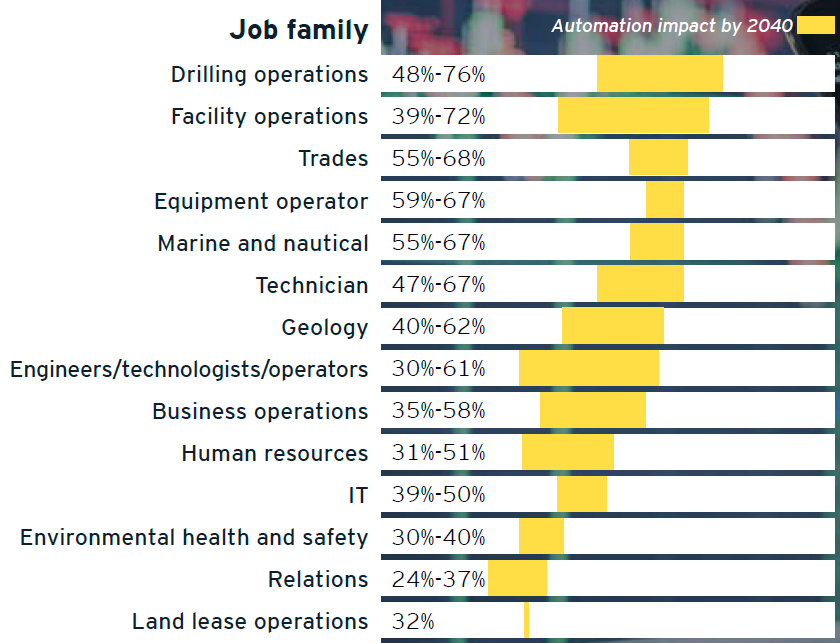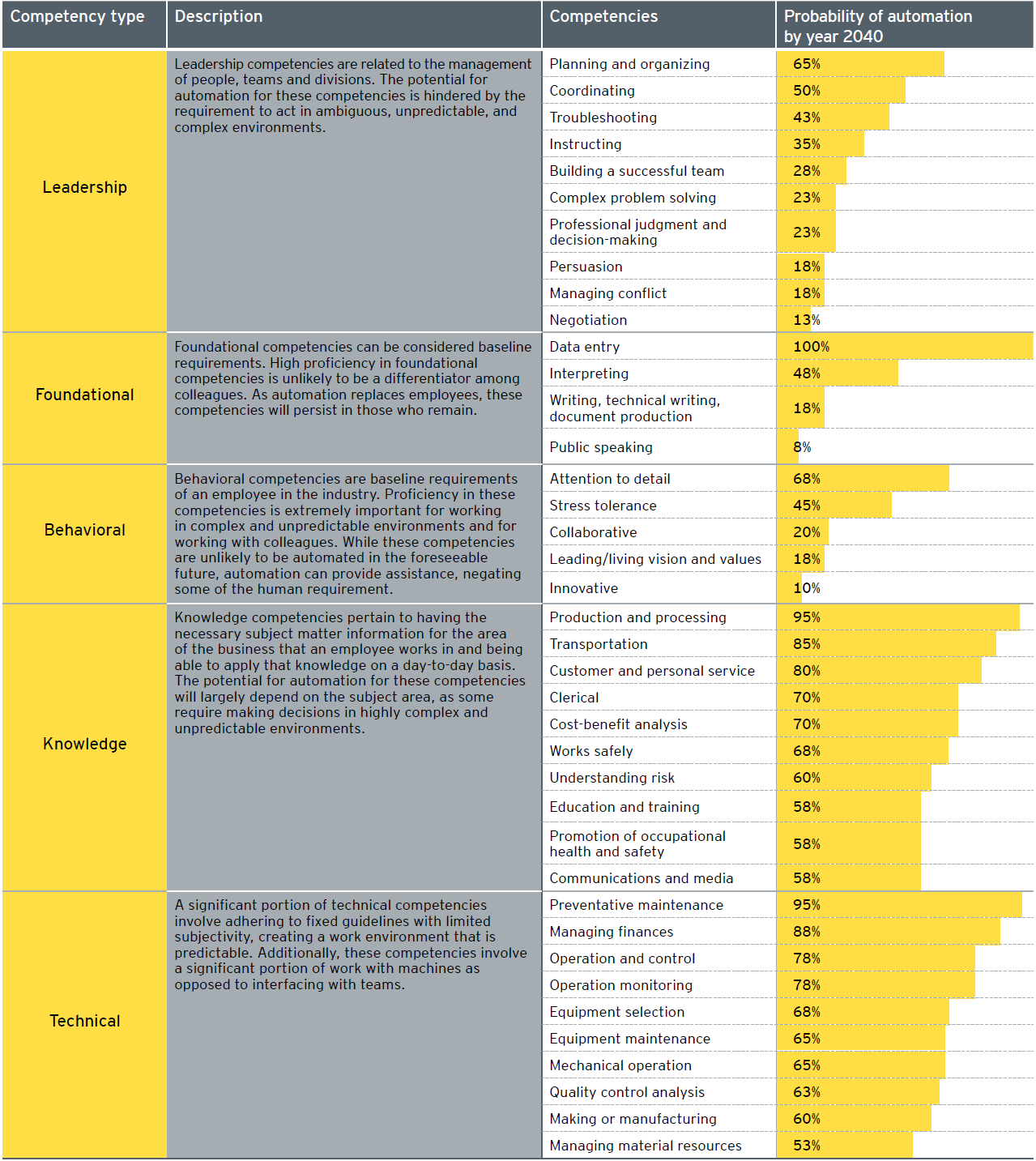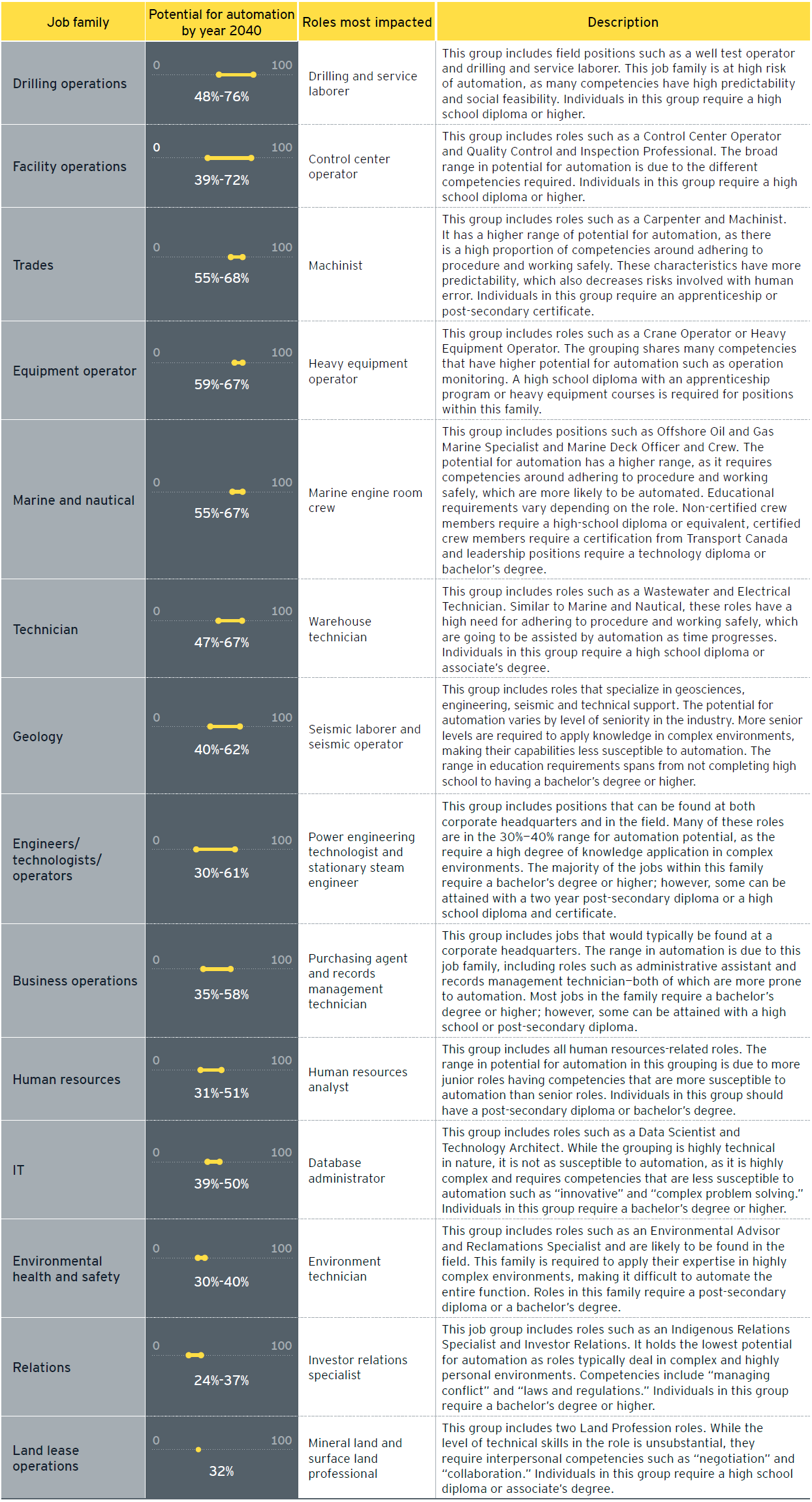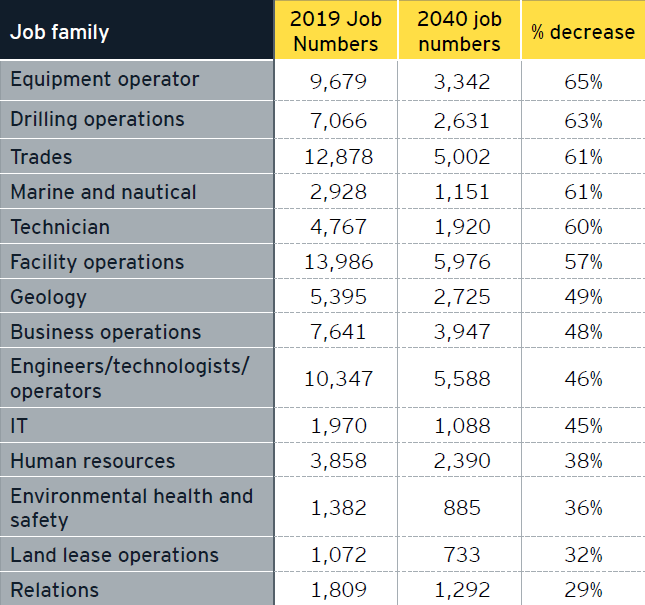EY refers to the global organization, and may refer to one or more, of the member firms of Ernst & Young Global Limited, each of which is a separate legal entity. Ernst & Young Global Limited, a UK company limited by guarantee, does not provide services to clients.

The oil and gas industry faces an unprecedented shift in its workforce as automation and artificial intelligence (AI) continue to transform the way companies operate. Now more than ever, oil and gas organizations are using technology to drive down production costs to improve margins as they fight prolonged drops in oil prices.
Increasing the use of technology will do more than just improve margins. It will change activities and even displace jobs. These trends and the rise in the adoption of automation and AI in the oil and gas industry requires organizations to examine how the sector’s jobs will evolve over the next 20 years. Oil and gas organizations have already started using technology to increase optimization and reduce costs, but what does this efficiency-driven change mean for the industry, companies and workers longer term? How does the oil and gas industry need to prepare for the job changes that these technologies bring?
To examine the impact of automation and AI on upstream oil and gas jobs, and to see how prone upstream oil and gas jobs are to technology, EY has partnered with the Petroleum Labour Market Information (PetroLMI) Division of Energy Safety Canada to analyze the likelihood of automation for various role competencies. By evaluating how prone these competencies are to automation, we can infer the future impact on upstream oil and gas jobs.
Download the full report
COVID-19 response
The research and development of this report began months before COVID-19 was declared a pandemic and caused global economic upheaval. While we don’t currently believe the pandemic will change our findings and impacts in the long
term, we think it’s prudent to address the changes we have seen and may continue to see in the short term.
Most notably, in response to the economic climate, spending has been significantly reduced among upstream oil and gas organizations. Operating expenditures have been cut and non-essential capital projects have been slashed from many budgets in an effort to reduce costs across the industry. We’ve specifically seen these cuts impact technology projects, likely slowing the short-term implementation and adoption of automation and AI in oil and gas.
These cost reduction efforts have resulted in thousands of layoffs and there are likely more to come. As we look to the future, a jobless recovery is becoming a real possibility, whereby companies look for ways to add capacity and capability not through hiring more people, but through using technology and automation. In the longer term this increased use of technology will be recognized by the markets.
Although governments will be pushing different sectors to create jobs to support the economy, the private sector will continue to be rewarded based on traditional metrics, such as the cost to operate and will turn to technology to help drive efficiency over the next two decades.
While it’s hard to predict when the pandemic will end or how long it will take for the economy and oil and gas spending to rebound, we do believe that the adoption of automation and AI will resume its pre-pandemic trajectory and ramp back up in the long term. Companies will be looking to drive efficiency through automation like never before and those that continue to produce energy will only be able to do so because of their scale and low costs.

Chapter 1
Findings
The automation and AI impact on an oil and gas organization can be considered from multiple perspectives. Understanding the impact on competency types can help individuals, organizations and educators retool skillsets as the shift gradually takes place. Understanding the impact on individual jobs and job families provides valuable insight into planning the workforce of the future.
As discussed, competencies have been grouped into five broad categories based on their characteristics: Leadership, Foundational, Behavior, Knowledge and Technical. Individual roles have been grouped into one of 14 families based on multiple factors, including competency profiles, American Petroleum Institute groupings and groupings that are commonly accepted in industry.
Our competency analysis shows the expected impact on competencies by the year 2040. Technical competencies have the most potential for automation due to the high level of predictability and social feasibility. Additionally, many organizations have already begun digitizing technical competencies and the economic feasibility is expected to improve in the coming years. On the other end of the spectrum, leadership competencies have the least potential for automation. A common characteristic of leadership competencies is that their automation is unlikely to be socially feasible for the foreseeable future.
Table 3. Competency categories.

Analysis into individual roles and groupings of job families resulted in a noticeable difference in the potential for automation by the year 2040. The broad range in each individual job family reflects the differences individual roles can have that change their susceptibility to automation. The expected impact of automation and AI is likely to be felt differently across the organization, as some job families are significantly more susceptible to having jobs replaced.
Figure 1. Potential for job family automation.

Findings part 1
In each of the competency types, there are competencies that were assessed using the automation criteria previously discussed on pages 5 and 6. Each competency type has a different number of total competencies. Table 4 lists the competencies that have the highest potential for automation.
Table 4. Probability of automating competencies.

Findings part 2
A job family is a broad grouping of jobs in a career emphasis. Using competency profiles, job activities, American Petroleum Institute groupings3, and commonly accepted industry groupings, 14 job families were established to group roles and understand impacts on different parts of an organization. To understand the range of automation potential for each job family, individual competency scores were applied to every role in the industry and roles were then grouped into families.
Table 5. Job family potential for automation.


Chapter 2
Impact on oil and gas
The mining, quarrying and oil and gas extraction industry is one of the main contributors to Canada’s GDP4. We understand that even during times of greater stability, oil and gas companies are slower than some other industries in investing and adopting new technologies and with current economic and operating environments, this is being perpetuated.
However, several factors – such as higher operating costs compared with other markets, low commodity prices and the energy transition – are forcing Canadian producers to find efficiencies. Automated technologies will be even more critical in remaining competitive and it is important for organizations to be prepared for the operational changes.
Based on our analysis, there are very few, if any, jobs and competencies that will not be impacted by automation in the future, signaling to the oil and gas industry the importance of preparing for the shift now.
Industry impacts
The primary benefit of adopting new technologies is the cost savings achieved through greater efficiency, increased quality and control, improved predictability, safety and continuous operations. As more activities shift toward being completed by a machine rather than a human, we can expect there will be significant workforce impacts across the oil and gas industry.
Table 6. Job number changes by job family.

Roles not included in the analyses due to inconsistent data are as follows:
Managers in Natural Resources Production, Construction Managers, Drilling and Well Servicing, Shippers and Receivers, and Purchasing and Inventory Control Workers.
Workforce reduction
It’s estimated that in 2019, approximately 86,000 individuals were employed in these exploration and production and oil sands positions in Canada5. Applying our impact analysis results, we can see that a significant portion of work activities can be automated, thereby reducing workforce demand. These reductions will most likely occur through natural attrition rather than mass layoffs.
Industry appeal
Findings from the 2017 EY Oil and Gas US Perceptions Study found that 62% of Generation Z and 44% of Millennials are not attracted to careers in the industry6. The use of advanced technologies could help increase the appeal to the upcoming tech-savvy workforce. Technologies can also be used to fill in talent gaps associated with the reduced appeal.
Talent pipeline
With the rise of the Fourth Industrial Revolution, there will be a higher demand for certain professions such as data scientists and software developers and the industry will find itself having to compete outside its walls for this talent. To develop the highly skilled and educated workforce it will need in the future, the oil and gas industry would be wise to programs and partner with institutions to educational programs and institutions to begin building its talent pipeline now.
Knowledge retention
Automation will also reduce the effects of the “brain drain.” As the older generation retires, the industry is at considerable risk of losing institutional knowledge gained through decades of experience. New tools and technologies will be able to retain this knowledge and data, ensuring consistent operations and performance.
Company impacts
Realizing the complete benefits of these new technologies will only be achieved if oil and gas organizations shift their operations to support adoption. Virtually every type of job will change as a result of automation, from corporate functions such as Finance and IT, to field work such as maintenance and facility operations. The current ways of working may no longer be possible and companies need to start considering the impacts to operating models.
HR strategy
HR departments will play a key role in driving successful adoption and sustainment of new technologies. If not there already, HR leaders should have a seat at the executive level table, helping to define organizational strategies. HR teams will also need to relook at optimal workforce mix as the type of work and alternative work arrangements, are more easily managed remotely. Companies may also need to readjust strategies to consider outsourcing what doesn’t fit with their core capabilities.
Talent retention
This new labor pool will be motivated differently than today’s current workforce, requiring organizations to shift their performance management and reward systems to optimize retention. Many highly skilled individuals are motivated by the opportunity for diverse and intriguing work, the flexibility stemming from working remotely and the ability to find an employer that matches their value system.
Talent acquisition
The need for digitally fluent, multidisciplinary employees will require significant upskilling of the current workforce, as well as a focus on acquiring new talent to supplement what can’t be taught in-house. The acquisition of different talent will cause a shift from traditional hiring processes to ones such as the use of online platforms to attract highly skilled people who comprise the gig economy. Technology can also be employed to support these efforts by automatically scrolling through talent data to find optimal skillsets.
Leadership development
Proper leadership development will be a requirement for success. Leaders will need to be equipped to handle unprecedented change and uncertainty, to navigate through the rapid shift in technologies and to manage a new and diverse workforce, all while still driving achievement of traditional business objectives.
Worker impacts
The impacts to individual workers will vary depending on profession, aptitude for change and degree of digital literacy. But, as previously shown, virtually no job will be untouched by this change. This means that workers will be required to reskill and upskill to remain employed in upstream oil and gas.
Skill development
A focus on developing skills in emotional intelligence, critical thinking, data analysis and managing the interface between human and machine will be important in staying competitive in the job market. As found in our analysis, there are some competencies that will be less likely to be impacted by automation and will be critical attributes of the future worker.
Job selection
Younger generations not currently part of the labor market will need to look forward and position themselves to be successful in the future workforce, as certain jobs will undoubtedly be completely replaced by technology. It will also be important to develop a cross-functional skill set that allows people to contribute to multiple areas of an organization, thereby making themselves more agile and valuable.

Chapter 3
How to respond
These impacts may seem overwhelming, but they are not insurmountable. With the right outlook and preparation, oil and gas organizations can position themselves to take full advantage of the changes associated with automation. A key component will be to build a workforce that thrives in the new environment. Companies can begin that journey by taking a few key steps now.
Step 1: Assess your current state and identify gaps
Understanding your current workforce knowledge and skill set will help identify where your strengths lie and where there are gaps that need to be filled. This will help determine what is required in the form of upskilling or reskilling of employees, acquiring new talent and potentially outsourcing to another party.
Automated technologies aren’t just for the business, either. They can also help optimize HR processes and obtain data-driven insights. Optimizing HR processes will highlight how operating models need to shift to manage human and non-human workforces.
Some key items for consideration include:
- What are the key skills and capabilities needed in your workforce?
- What are the capabilities of your leaders in driving transformation?
- Will you need additional instructors to support upskilling?
Step 2: Define your strategy and future objectives
Automation is an enabling capability that can automate and enhance business processes. Knowing what you’d like to achieve through automation is the first step in defining your organization’s digital strategy.
A strategy should encompass what your organization wants to be and how to achieve it, its overarching direction and a clear mandate. The strategic objectives establish a course of action that balances the organization’s immediate needs with a longer-term outlook. Defining your strategy requires setting the direction, examining capital and resource allocation, integrating the long-range business plan and setting targets.
Some key items for consideration include:
- What are the areas where automation can contribute to your strategy?
- How can you improve productivity and reduce costs without compromising quality and safety?
- What can you do to differentiate yourself against your competitors? Or for your clients?
Step 3: Define your target operating model and organizational design
By identifying operational focus areas for deploying automated solutions, you can then define the organization’s operating model for implementing and managing new technologies in an integrated manner. This will not only dictate the types of skills required, but also the number of workers required for sustainment.
Operating model options run on a scale from centralized operations to federated at scale, with varying degrees of costs and benefits. Choosing the right model for your organization is key to a successful transformation.
Some key items for consideration include:
- Will your organizational hierarchy still function?
- What will drive automation in your organization?
- How will you be successful driving automation?
Step 4: Adjust behaviors to support the change
As with any change, ensuring your workforce is prepared to adopt the new way of operating is critical to success and there are behavioral shifts that you can begin today in preparation. Leaders can instill confidence by providing a clear vision of the end state, highlighting opportunities for career development and reducing the fear of job displacement. Increasing empathetic behaviors with others has shown to improve teaming and collaboration, which will be crucial for the effectiveness of cross-functional teams (think business, IT and HR working together).
Adopting automation will also require a shift in organizational mindset. It’s not a “one and done” deal. Leaders will need to monitor external changes in the market and continuously stay ahead of the latest technologies.
Some key questions to consider:
- What is your current culture like? What needs to change in your culture to successfully transform and adopt the new way of working?
- Is the organization agile and fluid enough to quickly and effectively adopt new technologies?
Success factors Contributors
Transforming an organization and its workforce is no small feat and there are several factors that need to be considered to improve the probability of success.
- Focus on the problem the company is trying to solve and not on the technologies themselves.
- Create a diverse mix of teams and skillsets.
- Assess the current workforce regularly as the landscape continuously evolves.
- Consider the role of HR in the future and how HR itself will need to evolve.
- Work with educators to identify the types of graduates needed to build a future workforce with the required skills.
- Identify the types of learning opportunities companies can offer internally to employees right now.
- Create workforce plans that can flex with evolving crude prices and global supply and demand.
- Refocus the “employee experience” to improve morale, engagement and loyalty levels.
Contacts
To learn more, please contact:
Lance Mortlock
Partner, Strategy
Ernst & Young LLP
Lance.mortlock@ca.ey.com
+1 416 206 5277
Robert Alexander
Associate Partner, People Advisory Services
Ernst & Young LLP
robert.alexander@ca.ey.com
+1 403 206 5195
Download the full report
Summary
Technologies such as robotic process automation, artificial intelligence, natural language processing and machine learning could reduce the oil and gas workforce by up to 30% and automate 50% of job competencies in the upstream sector in the next 20 years. Human resource and IT departments will play a key role in driving successful adoption and sustainment of new technologies and the optimal workforce mix. Workers will need to develop skills in emotional intelligence, critical thinking, data analysis and managing the interface between human and machine to be competitive in the upstream oil and gas job market.
The EY Preparing for the future now: Rethinking the oil and gas workforce in 2040 report, written in partnership with the Petroleum Labour Market Information (PetroLMI) Division of Energy Safety Canada, examines the future job landscape.



